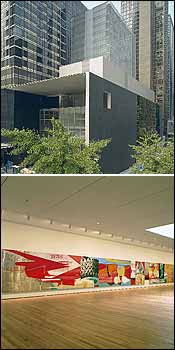
The Museum of Modern Art must change to stay the same. During its 75-year history, it has regularly remade itself in order to capture the ever-shifting character of the modern world. This November, the museum will complete its largest transformation, when it moves into a $425 million facility nearly twice its previous size.
Designed by the Japanese architect Yoshio Taniguchi, the museum is deceptively simple in appearance. Its exterior is restrained and visually calm, a measured creation of glass, granite, and aluminum (not, in other words, a flashy Frank Gehry extravaganza). The main building is six floors high and incorporates parts of earlier versions of MoMA, notably the 1939 “International Style” 53rd Street façade by Philip Goodwin and Edward Durrell Stone.
The interior is more dramatic. Visitors will enter the building from either 53rd or 54th Street and discover at its heart a 110-foot-high atrium that brings an expansive feeling of light and space. As they move around, they will catch glimpses of the surrounding city and see below them the Abby Aldrich Rockefeller Sculpture Garden, the legendary New York oasis that’s being restored to its original 1953 size.
Total exhibition space will increase from 85,000 to 125,000 square feet. On the second floor, in a vast, column-free area with 22-foot-high ceilings, MoMA’s curators will exhibit art made since 1970. The huge scale of this space will allow them to show the large works of the period; the second floor will also include a café, a reading room, the department of prints and illustrated books, and a space designed to show video art and other technologically based works. The third floor will contain the drawing, photography, and architecture-and-design departments. The fourth and fifth floors will house MoMA’s permanent collection of painting and sculpture. Usually, special exhibitions will occupy the sixth floor.
MoMA is planning a series of three small exhibitions about its metamorphosis: “Nine Museums by Yoshio Taniguchi” will examine the architect’s designs for other art museums; “Projects 82: Mark Dion, Rescue Archaeology” will present artifacts (such as cornices and wallpaper) excavated from the townhouse of John D. Rockefeller Jr., which was destroyed in 1939 to make way for the museum; and “Michael Wesely: Open Shutter” will be an exhibit of photographs of the construction made with unusually long exposures.
But few people will visit MoMA to see these exhibits. The real show is the new museum itself. Already, the questions that will excite and titillate the art world are beginning to form. How has our point of view changed since the last major transformation of MoMA? How will the curators tell the story of modern art? Who will be elevated, slighted, reconsidered? Will the curators serve as priests, professors, or populists? And what is the spirit of this new place in the heart of Manhattan? At the outset of the 21st century, in the new MoMA, we’ll find an intriguing new portrait of ourselves. Museums are haunted houses. And museums are mirrors.
Museum of Modern Art, 44 West 53rd St.; reopens November